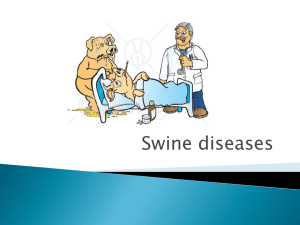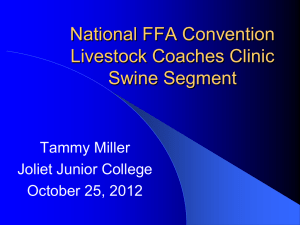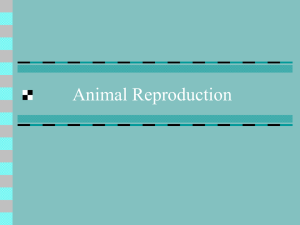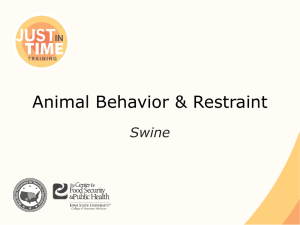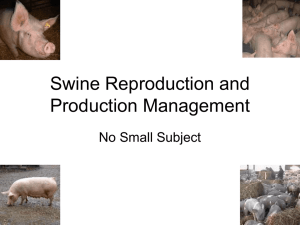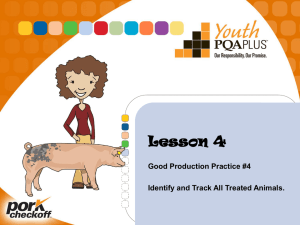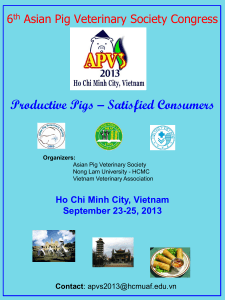The Swine Industry - Uintah High School FFA
advertisement
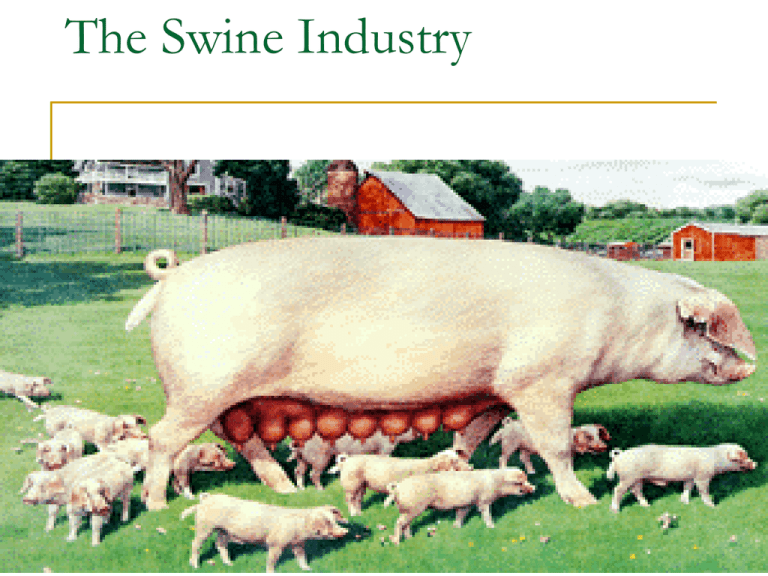
The Swine Industry Swine (Pig) Production Swine (Pig) Production Main Purpose – to produce pork for Human consumption Swine Terms What Boar What do you call the act of giving birth? Farrowing What do you call a mature female hog? Sow What do you call a mature male hog? do you call a castrated male hog? Barrow Swine (Pig) Production Terms for Understanding Castration – the removal of testicals from the male swine for the purpose of improving feed conversion, disposition and meat quality Swine (Pig) Production Terms for Understanding Boar– A male pig not castrated that is used for breeding purposes Barrow- A male pig that IS castrated that is entirely meant for pork production Livestock Terms What Piglet What do you call a young female hog? Gilt What is a new born hog called? is the gestation for hogs? 114 days or 3 months, 3 weeks, & 3 days The Swine Industry Number of operations has decreased in the past 30 years 1950, over three million producers Today, over 100,000 producer Number of hogs slaughtered has increased Farms have grown in size; 53 percent of them now produce 5,000 or more pigs per year. Nearly 21 billion pounds of pork were processed from about 110 million hogs in 2011. A total of 2.3 million metric tons of pork valued at more than $6.3 billion was exported in 2012. Labor requirements per pound of pork produced are relatively low The need for manual labor is reduced with the use of automated confinement facilities The investment in confinement facilities is higher than it is for simpler systems such as raising hogs on pasture However, few farmers today use pasture raising systems for swine production The Swine Industry Per capita consumption United States ranks second to China in production United States ranks l3th in consumption Pork in the American diet Concern over fat Education by the National Pork Producers Council History of the swine industry Columbus brought swine on his journey to the United States Hernando de Soto first introduced swine to the United States Today’s wild hogs are ancestors of pigs that escaped captivity As settlers moved west, they took pigs with them Swine products Food Lard Cooking Soap Location of the swine industry Midwest South Iowa and North Carolina rank #1 and #2 respectively in pig numbers Overview of the Swine Enterprise Corn belt states remain the major swine producing region of the U.S. About 60% of all swine Availability of grain Mainly corn Breeds of swine Mother (large litter, high milk production) Yorkshire Landrace Sire (grow rapidly; well-muscled, meaty carcass) Duroc Hampshire Crossbreeds Swine Breeds American Landrace Berkshire Chester White Duroc Hampshire Hereford Pietrain Poland China Spotted Tamworth Yorkshire Duroc Originated from red hogs raised in the Eastern U.S. Red Ears that droop forward Misc.-Large Frame, Fast gainers, good mothers, Popular breed Very popular breed in the U.S. Hampshire Originated in England Black with a white belt that encircles the forepart of the body Erect ears Good rustling ability, muscle, and carcass leanness Popular breed Used in many crossbreeding programs Misc.-The “Meat Breed” Excellent Carcass Berkshire Originated in England Medium-sized hog that produces an acceptable carcass Black with six white points Head is slightly dished Erect ears Misc.-Short Snout, Meat type hog Emphasis on fast and efficient growth, meatiness, good reproduction Poland China Originated in Ohio Black with six white points Feet, face, tip of the tail Forward-drooping ears One of the larger breeds of hogs Carcasses have low backfat and large loin eyes, Long body thick hams Used in many crossbreeding programs Spotted Developed in Indiana Black and white Forward-drooping ears Similar body type to Poland China Breeders strive to produce a large-framed hog with efficient gains and good muscling Color-no less than 20% or more than 80% White Misc.-Good mothers, fast gainers Chester White Originated in Chester County, Pennsylvania White Ears droop forward Mothering ability Color-White with blue freckles Misc.-good mothers, large frame Yorkshire Originated in England in the county of Yorkshire White Erect ears Slightly dished face The mother breed. Large litter, high feed efficiency, rapid growth, good mothering ability, long carcasses American Landrace Originated in Denmark White Long bodied Ears lop forward and down Mothering ability Large litters Extremely Long Bodies Tamworth Originated in Ireland Considered to be the oldest of the purebred breeds Red, with shades varying from light to dark Ears are erect Has a long head and snout Good mothers and large litters Good foragers Hereford Developed in Missouri, Iowa, and Nebraska Red with a white face Ears are forward drooping Prolific, good mothers, and have good rustling ability Pietrain Originated near the village of Pietrain, Belgium White with black spots Medium sized with erect ears, short legs, and muscular hams Exceptionally high lean to fat ratio Makes it desirable in genetic improvement programs Production Swine habits Wallow in mud to keep cool and fight off parasites Only use one area of their pen to drop waste Will not overeat Production, Cont. Swine and humans Similar digestive, circulatory, and other systems Swine tissues used to replace human heart skin Swine heart valves used to replace human heart valves Phases of industry Farrowing Growing Finishing Confinement operations Feed conversion ratio Diet High-protein diet to promote growth and muscle development High-carbohydrate diet later to develop fat Need ten types of amino acids Environmental concerns Odor and manure disposal Lagoons Regulated to prevent pollution of water Bacteria helps break down waste into slurry Waste used as fertilizer Swine Reproduction Ear Notching Universal Swine Identification system Tags will come off in the feed pen Swine Reproduction Ear Notching Swine Reproduction Ear Notching Swine Reproduction Ear Notching Quiz Swine Reproduction Ear Notching The right (litter) ear is equal to 9+3+3+1=16 The left (pig) ear is equal to 3 This is the 16-3 pig.


